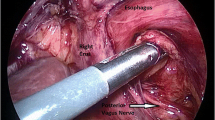Abstract
Introduction
Laparoscopic sleeve gastrectomy (LSG) and laparoscopic Roux-en-Y gastric bypass (LRYGB) are commonly performed bariatric procedures in obesity management. Gastroesophageal reflux disease (GERD) in this population has reported rates of 23–100%. GERD after LSG has been noted with recent studies demonstrating de novo reflux or symptom exacerbation despite weight loss. Fundoplication is not an option, and medically refractory GERD after LSG is usually treated with conversion to RYGB. GERD post-RYGB is a unique entity, and management poses a clinical and technical challenge. We evaluate safety and effectiveness of magnetic sphincter augmentation after bariatric surgery.
Materials and methods
A retrospective review of a prospectively maintained database was performed identifying patients that underwent LINX placement for refractory GERD after LSG, LRYGB, or duodenal switch across three institutions. Outcomes included complications, length of stay, PPI use, GERD-HRQL scores, and patient overall satisfaction.
Results
From March 2014 through June 2018, 13 identified patients underwent LINX placement after bariatric surgery: 8 LSG, 4 LRYGB, and 1 duodenal switch. The patients were 77% female, with mean age 43 and average BMI 30.1. Average pre-operative DeMeester score was 24.8. Pre-operatively, 5 patients were on daily PPI, 6 on BID PPI, and 1 on PPI + H2 blocker. We noted decreased medication usage post-operatively, with 4 patients taking daily PPI, and 9 off medication completely. A GERD-HRQL score was obtained pre- and post-operatively in 6 patients with average reduction from 25 to 8.5 (p value 0.002). Two patients experienced complications requiring endoscopic dilation after LINX placement. 100% of patients reported overall satisfaction post procedure.
Conclusion
LINX placement is a safe, effective treatment option for surgical management of refractory GERD after bariatric surgery. It can relieve symptoms and obviate the requirement of high-dose medical management. Magnetic lower esophageal sphincter augmentation should be another tool in the surgeon’s toolbox for managing reflux after bariatric surgery in select patients.

Similar content being viewed by others
References
Chang P, Friedenberg F (2014) Obesity and GERD. Gastroenterol Clin North Am 43:161–173
Gorodner V, Viscido G, Signorini F, Obeide L, Moser F (2018) Gastroesophageal reflux and morbid obesity: evaluation and treatment. Updates Surg 70:331–337
Herbella FA, Sweet MP, Tesesco P, Nipomnick I, Patti MG (2007) Gastroesophageal reflux disease and obesity. Pathophysiology and implications for treatment. J Gastrointest Surg 11:286–290
ASMBS. https://asmbs.org/resources/estimate-of-bariatric-surgery-numbers
Frezza E, IkramuddinS Gourash T, Rakitt A, Kingston A, Luketich J, Schauer PR (2002) Symptomatic improvement in gastroesophageal reflux disease (GERD) following laparoscopic Roux-en-Y gastric bypass. Surg Endosc. https://doi.org/10.1007/s00464-001-8313-5
Chen RH, Lautz D, Gilbert RJ, Bueno R (2005) Antireflux operation for gastroesophageal reflux after roux-en-y gastric bypass for obesity. Ann Thorac Surg 80(5):1938–1940
Parmar CD, Mahawar KK, Schroeder M, Boyle N, Balupuri S, Small PK (2017) Conversion of sleeve gastrectomy to Roux-en-Y gastric bypass is effective for gastro-oesophageal reflux disease but not for further weight loss. Obes Surg 27:1651. https://doi.org/10.1007/s11695-017-2542-8
Langer FB, Bohdjalian A, Shakeri-Leidenmühler S, Schoppmann SF, Zacherl J, Prager G (2010) Conversion from sleeve gastrectomy to Roux-en-Y gastric bypass—indications and outcome. Obes Surg 20:835. https://doi.org/10.1007/s11695-010-0125-z
Tatum JM, Alicuben E, Bildzukewicz N, Samakar K, Houghton C, Lipham J (2018) Minimal versus obligatory dissection of the diaphragmatic hiatus during magnetic sphincter augmentation surgery. Surg Endosc. https://doi.org/10.1007/s00464-018-6343-5
Hawasli A, Sadoun M, Meguid A, Dean M, Sahly M (2018) Laparoscopic placement of the LINX® system in management of severe reflux after sleeve gastrectomy. Am J Surg 217:469–499
Sudan R, Jain-Sprangler K (2018) Tailoring bariatric surgery: sleeve gastrectomy, Roux-en-Y gastric bypass and biliopancreatic diversion with duodenal switch. J Laparoendosc Adv Surg Tech A. 28(8):956–961
El-Hadi M, Birch DW, Gill RS, Karmali S (2014) The effect of bariatric surgery on gastroesophageal reflux disease. Can J Surg 57(2):139–144. https://doi.org/10.1503/cjs.030612
Verban O, Hawasli A, Carlin A, Genaw JA, English W, Dimick JB, Wood MH, Birkmeyer JD, Birkmeyer NJ, Finks JF (2015) Variation in utilization acid-reduction medication at 1 year following bariatric surgery: results from Michigan bariatric surgery collaborative. Surg Obes Relat Dis 11(1):222–228
Desart K, Rossidis G, Michel M, Lux T, Ben-David K (2015) Gastroesophageal reflux management with the LINX® system for gastroesophageal reflux disease following laparoscopic sleeve gastrectomy. J Gastrointest Surg 19(10):1782–1786
Skubleny D, Switzer NJ, Dang J, Gill RS, Shi X, de Gara C, Birch DW, Wong C, Hutter MM, Karmali S (2017) LINX® magnetic esophageal sphincter augmentation versus Nissen fundoplication for gastroesophageal reflux disease: a systematic review and meta-analysis. Surg Endosc 31:3078. https://doi.org/10.1007/s00464-016-5370
Hawasli A, Phillips A, Tarboush M (2016) Laparoscopic management of reflux after Roux-en-Y gastric bypass using the LINX system and repair of hiatal hernia: a case report. Surg Obes Relat Dis 12:51–54
Souza M, Nobre RA, Bezerra PC, dos Santos AA, Sifrim D (2017) Anatomical and functional deficiencies of the crural diaphragm in patients with esophagitis. Neurogastroenterol Motil. https://doi.org/10.1111/nmo.12899
Author information
Authors and Affiliations
Corresponding author
Ethics declarations
Disclosures
Dr. Horgan has stock options with TORAX™ Medical Inc. Dr. Smith has a pending stock option payment from TORAX™ Medical Inc. Dr. Jacobsen has two grants with TORAX™ Medical Inc, the first for The CALIBER Study: Randomized Controlled Trial of LINX versus Double-Dose Proton Pump Inhibitor Therapy for Reflux Disease, and the second for A Post-Approval Study of the LINX ® Reflux management system. Drs. Broderick, Cheverie, Omelanczuk, Lee, Dominguez-Profeta, Cubas, Sandler, and Fuchs have no conflicts of interest or financial ties to disclose.
Additional information
Publisher's Note
Springer Nature remains neutral with regard to jurisdictional claims in published maps and institutional affiliations.
Rights and permissions
About this article
Cite this article
Broderick, R.C., Smith, C.D., Cheverie, J.N. et al. Magnetic sphincter augmentation: a viable rescue therapy for symptomatic reflux following bariatric surgery. Surg Endosc 34, 3211–3215 (2020). https://doi.org/10.1007/s00464-019-07096-z
Received:
Accepted:
Published:
Issue Date:
DOI: https://doi.org/10.1007/s00464-019-07096-z




